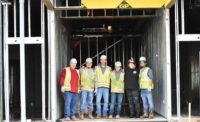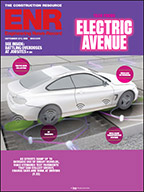More Blind-Spot Sensors Make Jobsites Safer

According to the National Institute for Occupational Safety and Health, most work-zone fatalities are due to a heavy truck or machine striking a ground worker, and half those deaths occur when a vehicle is backing up. Contractors looking to improve safety are pushing machinery suppliers to offer object-detection technology, which is now common on new cars and light trucks.
With their large wheels, rear counterweight and pivoting boom, telescopic handlers, or telehandlers, are one type of machine being targeted. Balfour Beatty Construction has a national agreement with Sunbelt Rentals to install proximity alarms on any telehandler shipped to jobsites, and safety executives say they are an important risk-management tool.
"The use of telehandlers on construction has exploded in recent years," says Steve Smithgall, senior vice president of loss control for Dallas-based Balfour Beatty. "Despite some manufacturer improvements, they still have blind spots."
The risks are significant. On average, telehandlers are the most used pieces of machinery within national rental fleets. According to Beverly Hills, Calif.-based Rouse Analytics, telehandlers last September were out on rent more than 80% of the time, at least 10 percentage points higher than the utilization average of 70.8%. Telescopic-boom lifts were the next-most-utilized category, at 75%.
Rouse and others attribute the rising demand to telehandlers' versatility. "Because they have the ability to drive with front-wheel steering and crab-steering modes in tight areas, the caution zone around them can quickly change," Smithgall says. "As a result, we utilize proximity sensors and cameras to help mitigate the risk of accidents occurring when operating these pieces of equipment."
Sunbelt buys the ruggedized pulse-radar sensors from Boise-based PreView Radar Systems, which invented them in 2000 for large mining trucks. "We knew if the system survived in that extreme environment, we would be able to save lives in every other industry," says Teresa Prisbrey, PreView's director of marketing. Continuously monitoring proximity, it is far more than a parking aid. Costs were not disclosed, but "it is less than the cost to replace most bumpers," Prisbrey says. The units take an hour to install and have a range of up to 32 ft.
More manufacturers are including sensors at the factory. At this year's World of Concrete, held on Feb. 3-6 in Las Vegas, Caterpillar displayed an optional PreView rear sensor and camera on a preproduction TL1055D telehandler. Deere offers them on select wheel loaders; JLG and others are expected to make them available soon, as well.




